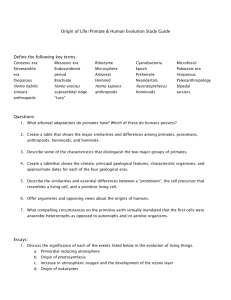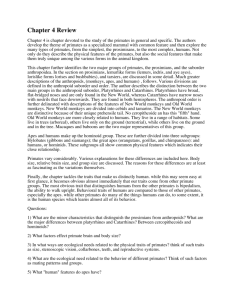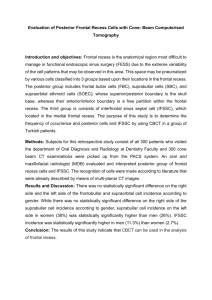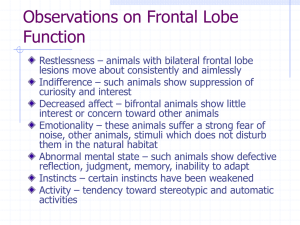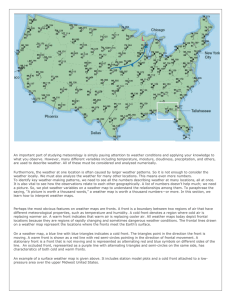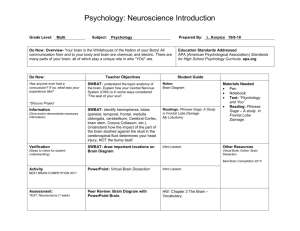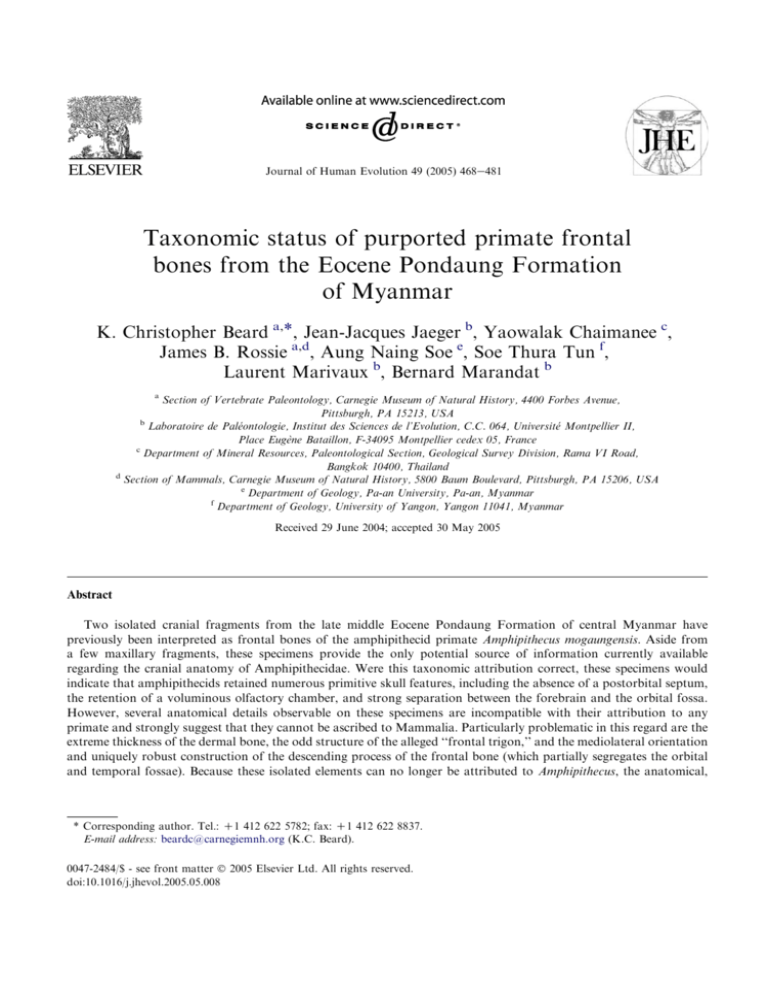
Journal of Human Evolution 49 (2005) 468e481
Taxonomic status of purported primate frontal
bones from the Eocene Pondaung Formation
of Myanmar
K. Christopher Beard a,*, Jean-Jacques Jaeger b, Yaowalak Chaimanee c,
James B. Rossie a,d, Aung Naing Soe e, Soe Thura Tun f,
Laurent Marivaux b, Bernard Marandat b
a
Section of Vertebrate Paleontology, Carnegie Museum of Natural History, 4400 Forbes Avenue,
Pittsburgh, PA 15213, USA
b
Laboratoire de Paléontologie, Institut des Sciences de l’Evolution, C.C. 064, Universite´ Montpellier II,
Place Euge`ne Bataillon, F-34095 Montpellier cedex 05, France
c
Department of Mineral Resources, Paleontological Section, Geological Survey Division, Rama VI Road,
Bangkok 10400, Thailand
d
Section of Mammals, Carnegie Museum of Natural History, 5800 Baum Boulevard, Pittsburgh, PA 15206, USA
e
Department of Geology, Pa-an University, Pa-an, Myanmar
f
Department of Geology, University of Yangon, Yangon 11041, Myanmar
Received 29 June 2004; accepted 30 May 2005
Abstract
Two isolated cranial fragments from the late middle Eocene Pondaung Formation of central Myanmar have
previously been interpreted as frontal bones of the amphipithecid primate Amphipithecus mogaungensis. Aside from
a few maxillary fragments, these specimens provide the only potential source of information currently available
regarding the cranial anatomy of Amphipithecidae. Were this taxonomic attribution correct, these specimens would
indicate that amphipithecids retained numerous primitive skull features, including the absence of a postorbital septum,
the retention of a voluminous olfactory chamber, and strong separation between the forebrain and the orbital fossa.
However, several anatomical details observable on these specimens are incompatible with their attribution to any
primate and strongly suggest that they cannot be ascribed to Mammalia. Particularly problematic in this regard are the
extreme thickness of the dermal bone, the odd structure of the alleged ‘‘frontal trigon,’’ and the mediolateral orientation
and uniquely robust construction of the descending process of the frontal bone (which partially segregates the orbital
and temporal fossae). Because these isolated elements can no longer be attributed to Amphipithecus, the anatomical,
* Corresponding author. Tel.: C1 412 622 5782; fax: C1 412 622 8837.
E-mail address: beardc@carnegiemnh.org (K.C. Beard).
0047-2484/$ - see front matter Ó 2005 Elsevier Ltd. All rights reserved.
doi:10.1016/j.jhevol.2005.05.008
K.C. Beard et al. / Journal of Human Evolution 49 (2005) 468e481
469
phylogenetic, and behavioral inferences regarding amphipithecid paleobiology that have been drawn from these
specimens can no longer be sustained.
Ó 2005 Elsevier Ltd. All rights reserved.
Keywords: Amphipithecidae; Eocene; Pondaung Formation; Myanmar; Anthropoid origins
Introduction
Few fossil primates have engendered greater
longstanding phylogenetic controversy than Pondaungia cotteri and Amphipithecus mogaungensis
from the late middle Eocene Pondaung Formation
of Myanmar (Pilgrim, 1927; Colbert, 1937). Both
were initially described as primitive anthropoids,
a view that has remained prevalent ever since (e.g.,
Simons, 1971; Ba Maw et al., 1979; Ciochon et al.,
1985; Jaeger et al., 1998, 2004; Chaimanee et al.,
2000; Ducrocq, 2001; Beard, 2002; Marivaux
et al., 2003; Takai and Shigehara, 2004). Alternative
ideas regarding the phylogenetic affinities of Pondaungia and Amphipithecus have ranged from von
Koenigswald’s (1965) early assertion that Pondaungia
is a condylarth to repeated claims that Pondaungia
and/or Amphipithecus are uniquely specialized adapiform primates bearing only convergent similarities with early anthropoids (Szalay, 1970, 1972;
Ciochon and Holroyd, 1994; Ciochon et al., 2001;
Gunnell et al., 2002; Ciochon and Gunnell, 2002a,b,
2004). Recent phylogenetic analyses of early anthropoid relationships underscore this systematic
uncertainty (Kay et al., 2004b).
At least in part, this lack of consensus reflects
the nature of the fossil material that has been
attributed to Pondaungia and Amphipithecus. Isolated cranial and postcranial elements from the
Pondaung Formation have been allocated to both
taxa (Ciochon et al., 2001; Takai et al., 2003;
Marivaux et al., 2003). With the exception of the
talus described by Marivaux et al. (2003), these
isolated finds emit a phylogenetic signal seemingly
at odds with the evidence yielded by amphipithecid
jaws and teeth. Possible explanations for this
apparent character conflict include homoplasy,
mosaic evolution, and the incorrect allocation of
isolated and fragmentary fossils to taxa that were
originally established solely on the basis of dental
remains. Here, we show that the latter factor
explains the difficulty in reconciling the anthropoid-like dentitions of Pondaungia and Amphipithecus with the very primitive craniofacial anatomy
implied by two isolated cranial fragments that have
recently been attributed to Amphipithecus.
Previous work
Both cranial fragments were collected by scientists working under the auspices of the ‘‘Myanmare
Japan Pondaung Expedition Team’’ (Than Tun,
2000; Takai et al., 2000, 2003) (Figs. 1e2). The first
specimen, National Museum of Myanmar Primate
19 (abbreviated hereafter as NMMP 19), was
recovered in November 1999 at the Paukkaung
kyitchaung 2 locality in the vicinity of Bahin
village. In the field, NMMP 19 was found near
a right maxillary fragment of Amphipithecus
mogaungensis (NMMP 18), and the two specimens
have usually been regarded as representing the
same individual. Despite its fragmentary condition
and ambiguous allocation to Amphipithecus,
NMMP 19 has attained a surprising degree of
prominence during the past five years. The specimen was illustrated, but neither described nor
discussed in any detail, by Than Tun (2000) and
Takai et al. (2000). Takai et al. (2000: Fig. 9)
figured NMMP 19 alongside the NMMP 18
maxilla and referred to both elements as ‘‘the
newest specimen of A. mogaungensis,’’ thereby
implying that they pertained to the same individual.
Slightly more than a year later, a second specimen
(NMMP 27) bearing morphology comparable to
NMMP 19 was found at the Paya Ama kyitchaung
1 locality in the vicinity of Sinzwe village.
Although neither NMMP 19 nor NMMP 27
had yet been studied or described by members
of the scientific team that recovered them, the
specimens rapidly attracted the attention of other
workers seeking to address the phylogenetic
470
K.C. Beard et al. / Journal of Human Evolution 49 (2005) 468e481
position of amphipithecid primates. Gunnell et al.
(2002) published additional photographs of
NMMP 19, announced the existence of NMMP
27, and made some brief anatomical observations
pertaining to both specimens. In contrast to Than
Tun (2000) and Takai et al. (2000), who identified
NMMP 19 as a parietal fragment, Gunnell et al.
(2002: 362) recognized both NMMP 19 and
NMMP 27 as frontal bones that ‘‘potentially
may represent Amphipithecus.’’ Despite their hesitation regarding the systematic allocation of
NMMP 19 and NMMP 27, Gunnell et al. (2002)
felt confident enough to score two important
charactersdpresence or absence of postorbital
closure and presence or absence of a fused metopic
suturedin the cells pertaining to Amphipithecus in
the character-taxon matrix they constructed for
phylogenetic analysis (see Gunnell et al., 2002:
Tables 5e6). In contrast to the derived character
states that occur in undoubted anthropoids,
Gunnell et al. (2002) determined that both postorbital closure and a fused metopic suture were
absent in NMMP 19 and NMMP 27. They further
indicated that these specimens exhibit a high
degree of postorbital constriction of the braincase
(similar to that found in Adapis). Based partly on
the presence of these notably primitive cranial
features in Amphipithecus, the phylogenetic analysis undertaken by Gunnell et al. (2002) yielded
a clade containing large-bodied amphipithecids
and the North American notharctid adapiform
Hesperolemur. Having thus corroborated their
earlier suspicions regarding the notharctid affinities of amphipithecids (Ciochon and Holroyd,
1994; Ciochon et al., 2001), these authors proceeded to hypothesize that the derived dental
features shared by amphipithecids and undoubted
anthropoids were merely convergent ecological
adaptations for feeding on ‘‘hard objects and
tough-skinned fruits’’ (Gunnell et al., 2002: 369;
also see Ciochon and Gunnell, 2002a,b, 2004).
In a study focusing on the maxillary morphology of Pondaungia cotteri, Shigehara et al. (2002)
explicitly declared that NMMP 19 (which they
referred to as NMMP-KU 0229) is a frontal bone
pertaining to the same individual as the Amphipithecus maxillary fragment, NMMP 18 (which they
referred to as NMMP-KU 0228). In agreement
with Gunnell et al. (2002), they further noted: ‘‘On
the frontal bone, the postorbital process was
shaped like a bar and does not contribute a postorbital flange. These features...indicate that this
taxon [Amphipithecus] did not exhibit postorbital
closure’’ (Shigehara et al., 2002: 160). Without
necessarily endorsing adapiform affinities for
amphipithecids, they also emphasized that ‘‘this
pattern [i.e., the absence of postorbital closure in
Amphipithecus] presents problems for anyone who
wishes to conclude that amphipithecids are stem
anthropoids’’ (Shigehara et al., 2002: 161).
Takai et al. (2003) reiterated the direct field
association between NMMP 19 and NMMP 18.
Based on new measurements, they concluded that
NMMP 19 shows a lesser degree of postorbital
constriction than Gunnell et al. (2002) had
surmised. Takai et al. (2003) also observed polymorphism regarding fusion of the metopic suture
in NMMP 19 (in which the suture appears to be
fused) and NMMP 27 (in which the suture appears
to be unfused), which they believed might be
attributable to ontogenetic growth. On the basis of
an endocranial cast of NMMP 19, Takai et al.
(2003) reconstructed Amphipithecus as having
relatively voluminous olfactory bulbs that project
rostrally beyond the level of the frontal lobes of
the brain. Morphologically, the olfactory bulbs of
Amphipithecus were said to resemble the ‘‘bilobed’’
condition found in omomyids and microchoerids,
as opposed to the more divergent condition
characteristic of Eocene adapiforms.
Kay et al. (2004a) accepted earlier determinations that Amphipithecus lacks postorbital closure,
a condition that they regarded as being functionally linked with other features enhancing visual
acuity in anthropoids, such as the loss of a tapetum
lucidum and the presence of a retinal fovea.
Accordingly, Kay et al. (2004a: 7) concluded that
‘‘the absence of postorbital closure in Amphipithecus suggests this animal did not possess the acute
vision present in modern anthropoids.’’ Kay et al.
(2004a) also interpreted the relatively large olfactory bulbs of Amphipithecus (described by Takai
et al., 2003) as indicating that amphipithecids
retained a strepsirrhine-like reliance on olfaction.
In their recent analysis of anthropoid relationships, Kay et al. (2004b) emphasized the
K.C. Beard et al. / Journal of Human Evolution 49 (2005) 468e481
phylogenetic instability of amphipithecids. Working under the assumption that Amphipithecus lacks
postorbital closure, Kay et al. (2004b) found that
amphipithecids group with adapiforms under
most, but not all, of the character partitioning,
ordering, and weighting schemes they investigated.
Nevertheless, certain character assumption sets
utilized by Kay et al. (2004b) yield phylogenies
that recognize amphipithecids as anthropoids,
despite their supposition that amphipithecids lack
postorbital closure. Likewise, the phylogenetic
analysis conducted by Seiffert et al. (2004) recovered amphipithecids as basal anthropoids, despite its assumption that amphipithecids lack
postorbital closure.
Critical reappraisal of NMMP 19 and
NMMP 27
Given that skull features such as postorbital
closure are widely regarded to be crucial for
reconstructing the relationships of basal anthropoids, and given that NMMP 19 and NMMP 27
are currently the only specimens that potentially
illuminate this aspect of amphipithecid anatomy,
the morphology and taxonomic status of these
pivotal specimens require further scrutiny. We
observed several anatomical features in NMMP 19
and NMMP 27 that are inconsistent with their
identification as frontal bones of primates. These
traits are highlighted in the following sections.
For convenience, we describe the specimens as if
they were frontal bones (of some unknown taxon). In
fact, we are not confident that even this anatomical
(rather than taxonomic) attribution is correct.
Frontal trigon
In some living and extinct primates, the
temporal crests converge posteriorly to produce
a compound sagittal crest. In such forms, the area
circumscribed by these crests and the superior
orbital margins is known as the frontal trigon
(Tobias, 1967). Among Eocene primates, certain
adapiforms such as Adapis and Notharctus exhibit
particularly pronounced frontal trigons (e.g.,
471
Gazin, 1958; Gingerich and Martin, 1981). The
putative frontal bones from the Pondaung Formation have been described as having frontal
trigons as well, but several anatomical details
militate against this assessment.
As Takai et al. (2003) noted, the ‘‘frontal
trigon’’ of both Pondaung specimens is convex
(Figs. 1e3), which contrasts with the concave
topography of the frontal trigon that typically
occurs in primates (including such diverse fossils as
Adapis, Notharctus, Aegyptopithecus, and Afropithecus). With the exception of Chiropotes, a convex
frontal trigon is only found in those primates in
which a paranasal sinus inflates the underlying
bone (e.g., Archaeolemur, Smilodectes). However,
according to radiographs, the remarkably thick
squamous portions of NMMP 19 and NMMP 27
contain no pneumatized spaces (Takai et al.,
2003). In Chiropotes, the convexity of the frontal
trigon is due to the curvature of the large anterior
lobes of the brain immediately beneath it. In
contrast, the endocranial surface of the Pondaung
fossils is hardly even concave in the rostrocaudal
dimension. The slight curvature that does mark
the endocranial surface of these specimens fails to
influence the external topography of the skull due
to the extraordinary thickness of the intervening
bone. The frontal bones of some Eocene omomyids (e.g., Shoshonius, Tetonius, Hemiacodon)
exhibit a mildly convex surface topography, but
these forms lack a sagittal crest and their temporal
crests do not converge until they approach the
caudal end of the parietals. These cranial features
strain the definition of a frontal trigon while
yielding a total morphological pattern that diverges markedly from that shown by the Pondaung specimens. The temporal crests converge
farther rostrally in the Eocene microchoerid
Necrolemur, forming a modest sagittal crest.
However, the frontal bones of Necrolemur (and
omomyids) differ conspicuously from the Pondaung specimens in having the temporal crests and
orbital rims raised above the level of the trigon.
In addition to the important morphological
differences noted already, two conditions observable in NMMP 19 and NMMP 27 conflict with the
very definition of a frontal trigon. As described
above, a frontal trigon is produced by the posterior
472
K.C. Beard et al. / Journal of Human Evolution 49 (2005) 468e481
Fig. 1. Cranial fragments NMMP 19 (A, B) and NMMP 27 (C, D) from the Pondaung Formation, previously interpreted as frontal bones
of Amphipithecus mogaungensis. Specimens are depicted in dorsal (A, C) and ventral or endocranial (B, D) views. Scale bar equals 1 cm.
convergence of the temporal crests to form a midline sagittal crest. This condition is by no means
common in primates, and it usually arises as a result
of hypertrophy of the temporalis musculature
(Benefit and McCrossin, 1995). In both Pondaung
specimens, the ‘‘sagittal crest’’ projects rostrally
beyond the point where the temporal crests
converge near the midline. In NMMP 27 the
‘‘sagittal crest’’ extends at least 18 mm rostrally
beyond the location where the temporal crests
converge, spanning the entire length of the frontal
bone as it is preserved. In this specimen, the rostral
part of the ‘‘sagittal crest’’ forms a ridge that is split
by the metopic suture. In contrast, in NMMP 19
the ‘‘sagittal crest’’ divides into multiple ridges that
fan out asymmetrically to give the frontal trigon
a striated appearance. The frontal trigon of
primates is never adorned with ridges, even when
a metopic suture is present. To our knowledge, the
only placental mammal in which a midline crest
K.C. Beard et al. / Journal of Human Evolution 49 (2005) 468e481
473
Fig. 2. Explanatory drawing depicting the same specimens shown in the same orientations as in Fig. 1. Anatomical abbreviations are as
follows: dpf, descending process of the frontal bone; fms, fused metopic suture; ft, frontal trigon; oc, olfactory chamber; orb, orbit; pb,
broken root of postorbital bar; sc, sagittal crest; sss, superior sagittal sinus; tc, temporal crest; ums, unfused metopic suture. Scale bar
equals 1 cm.
occurs on the rostral part of the frontal bone is the
yellow armadillo, in which it serves as the site for
attachment of the orbitoauricularis muscle (Wible
and Gaudin, 2004).
In addition to the problematic rostral prolongation of the ‘‘sagittal crest’’ in the Pondaung specimens, the bilateral structures that have been
interpreted as temporal crests also conflict with
474
K.C. Beard et al. / Journal of Human Evolution 49 (2005) 468e481
Fig. 3. Cranial fragment NMMP 19 in right lateral (A) and anterior (B) views. Anatomical abbreviations are the same as in Fig. 2, with
the following additions: fbm, free bony margin of descending process of frontal bone; sif, superior intraorbital foramen. Scale bar
equals 1 cm.
anatomical patterns that are otherwise ubiquitous
among primates. In all fossil and extant primates,
whenever the temporalis musculature becomes
sufficiently enlarged to yield confluence of
the temporal crests (and particularly when this
convergence occurs a short distance from the
supraorbital costae, as is the case in Adapis,
Notharctus, and the Pondaung fossils), the sagittal
and temporal crests are distinct, raised features. In
contrast, the ‘‘temporal crests’’ on the Pondaung
fossils are low and rounded, and the ‘‘sagittal crest’’
is little more than a keel (Fig. 2A,C). The ‘‘temporal
crests’’ are almost indiscernible on NMMP 19 near
the midline, which is precisely where they should be
most pronounced, and at no point are they raised
topographically above the surface of the supposed
frontal trigon. Even more troubling is the fact that,
on both Pondaung specimens, the ‘‘temporal crests’’
do not appear to be bilaterally symmetrical. On
NMMP 19, the left ‘‘temporal crest’’ reaches the
midline rostral to the point where its right counterpart joins the ‘‘sagittal crest.’’ The opposite pattern
holds in NMMP 27. In neither case does postmortem deformation account for this asymmetry.
In summary, the ‘‘sagittal crest’’ in NMMP 19
and NMMP 27 does not appear to result from
K.C. Beard et al. / Journal of Human Evolution 49 (2005) 468e481
the confluence of the temporal lines, and it is
therefore not a true sagittal crest. The form of the
temporal and sagittal ‘‘crests,’’ as well as the
external topography of the adjacent bone, are
inconsistent with significant hypertrophy of the
temporalis musculature, which therefore cannot
be responsible for the rapid angle of convergence
of the ‘‘temporal crests.’’ Although various
aspects of the structures in question are vaguely
reminiscent of the primate frontal trigon, these
similarities are superficial and certainly nonhomologous.
Descending process of the frontal
The descending process of the frontal bone,
located at the junction of the orbital, temporal, and
anterior cranial fossae, consists of a massive pillar
of solid bone that is roughly rectangular in crosssection in both Pondaung specimens (Figs. 2e4).
As noted by Gunnell et al. (2002) and Takai et al.
(2003), the descending process of the frontal in
NMMP 19 preserves a natural bony margin
posteroinferior to the root of the supposed postorbital bar on the right side (Figs. 3e4). No
equivalent bony margin exists in anthropoids and
tarsiids because this is where the postorbital
septum separates the orbital fossa from the
adjacent temporal fossa in these taxa (Fig. 5A).
Accordingly, several authors have emphasized that
the free bony margin on the descending process of
the frontal in NMMP 19 indicates that a postorbital
septum did not occur in this specimen (Gunnell
et al., 2002; Shigehara et al., 2002; Takai et al.,
2003; Kay et al., 2004a,b; Ciochon and Gunnell,
2004; Takai and Shigehara, 2004). However, other
aspects of the descending process of the frontal
bone depart radically from the condition seen in
other primates, as well as in mammals generally.
In NMMP 19 the descending process of the
frontal bone forms a mediolaterally extensive,
coronally oriented bony wedge that would have
partly segregated the orbit from the temporal fossa
(Figs. 3e4). In living and fossil primates that lack
a postorbital septum, the descending process of the
frontal consists of relatively thin dermal bone that
contributes only to the sidewall of the braincase
475
(cf. Daubentonia as depicted in Fig. 4; Lemur in
Fig. 5B). The descending process of the frontal
bone in Eocene adapiforms such as Adapis does
not differ significantly from those of modern
primates without a postorbital septum. In contrast, in NMMP 19 the descending process of the
frontal flares laterally to form a coronally oriented
partial posterior wall to the orbit, even in the
region where the free bony margin occurs. Inferior
to this, the bone is poorly preserved, but its broken
surface indicates that the posterior orbital wall
would have extended even farther laterally here.
Although the free bony margin on the descending
process of the frontal demonstrates that a conventional postorbital septum was absent in NMMP
19, the mediolateral orientation of the extensive
bony wedge behind the orbit more closely approximates the condition in anthropoids and tarsiids
than it does the primitive arrangement in which no
bony barrier segregates the orbital and temporal
fossae. Indeed, the presence of this partial postorbital wall (if that is what this structure is)
distinguishes NMMP 19 from all vertebrates aside
from tarsiids and anthropoids (Cartmill, 1980;
Ross, 1994).
In addition to the free bony margin noted
earlier, an important distinction between the
descending process of the frontal in NMMP 19
and the postorbital septum of anthropoids and
tarsiids is the extraordinary robusticity of this
structure in NMMP 19, as opposed to the paperthin construction of the postorbital septum in
anthropoids and tarsiids (Figs. 4, 5A). At its
inferior (broken) margin, the descending process
of the frontal in NMMP 19 is 4.35 mm thick
(measured rostrocaudally). Cartmill (1980: 245)
noted that, in living haplorhines, ‘‘the postorbital
septum is formed by bony processes that grow
backward from the posteromedial edge of the
[postorbital] bar (or forward from the braincase)
along the cone-shaped sheet of free periorbita that
demarcates the orbital contents from the anterior
temporalis.’’ This ontogenetic pathway is difficult
to reconcile with the extreme robusticity of the
descending process of the frontal in NMMP 19.
This structure in NMMP 19 further differs from
the postorbital septum of living and fossil anthropoids in being composed of the frontal, rather than
476
K.C. Beard et al. / Journal of Human Evolution 49 (2005) 468e481
Fig. 4. Cranial fragment NMMP 19 (A) compared with skulls of the anthropoid Saimiri sciureus (BeC) and the strepsirrhine
Daubentonia madagascariensis (DeE), all in oblique right lateral view. Note the unique structure of the descending process of the
frontal bone in NMMP 19, which differs from that of primates in being much more robust and in flaring laterally rather than simply
contributing to the sidewall of the braincase. The volumetric outline in (A) is meant to clarify the extraordinary robusticity of this
element in NMMP 19; there is no reason to believe that the structure would have extended as far laterally as the outline indicates. The
zygomatic arch and parts of the postorbital bar/septum have been removed in (C) and (E) to facilitate comparisons with the
fragmentary Pondaung specimen. Anatomical abbreviations are the same as in Figs. 2e3. Specimens are not depicted at the same scale.
the zygomatic bone (Simons and Rasmussen,
1989). In agreement with previous workers, we
regard these differences as sufficient to rule out any
hypothesis of homology between the descending
process of the frontal bone in NMMP 19 and the
postorbital septum of anthropoids and/or tarsiids.
At the same time, we emphasize that nothing
approaching the condition in NMMP 19 occurs in
K.C. Beard et al. / Journal of Human Evolution 49 (2005) 468e481
477
Fig. 5. High-resolution computed tomography scans (lower image; oriented so that rostral is toward the top) through the orbital
regions (orb) of the anthropoid Callicebus moloch (A) and the strepsirrhine Eulemur fulvus (B). The white transverse lines shown in
lateral view (upper image) indicate the approximate plane of each scan. Note that, in primates, the descending process of the frontal
bone (dpf) consists of relatively thin dermal bone that contributes to the sidewall of the braincase, which contrasts with the condition in
the Pondaung fossils (see Fig. 4). In both taxa, the frontal sinus (fs) is labeled to avoid potential confusion with the nearby olfactory
chamber. Scale bars apply to upper images only.
other living or fossil primates (or in other
mammals, for that matter).
Postorbital constriction
In order to obtain a relative measure of postorbital constriction, Gunnell et al. (2002) compared the postorbital breadth of NMMP 19
(16.97 mm) to the length of M1 in NMMP 18
(5.84 mm), yielding a ratio of 2.91. This value is
smaller than the same ratio in Adapis parisiensis,
a species that is notable for exhibiting one of the
most severely constricted postorbital regions of
any primate. However, we agree with Takai et al.
(2003) that the points chosen by Gunnell et al.
(2002) to estimate postorbital breadth in NMMP
19 were inappropriate. Using the corrected measurement (21.38 mm) from Takai et al. (2003), the
ratio of postorbital breadth to M1 length becomes
3.66, which falls between the equivalent values for
Hesperolemur and Adapis (Gunnell et al., 2002).
However, if NMMP 19 does not pertain to
Amphipithecus, as we believe, then its degree of
postorbital constriction can only be estimated with
respect to other dimensions found on the same
specimen. One comparative metric that is useful in
this regard is interorbital breadth, as it is measured
between the preserved natural bone surfaces at the
superomedial corners of both orbits (minimum
interorbital breadth cannot be measured in this
specimen). In NMMP 19, interorbital breadth is
narrower than postorbital breadth, as is typical of
primates with relatively little postorbital constriction (e.g., Smilodectes, Galago, Eulemur, Loris).
The opposite condition describes primates having
severe postorbital constriction, such as Leptadapis
and Adapis (Lanèque, 1993). On this basis, NMMP
19 appears to exhibit relatively minor postorbital
constriction, but the endocranial morphology of
the specimen complicates this assessment.
Regardless of whether the frontal squama of
NMMP 19 was steeply inclined (cf. Takai et al.,
2003: Fig. 2a) or relatively horizontal in life, the
anterior cranial fossa would not have projected
over the orbits to any appreciable extent. The
forebrain of mammals always overlaps the orbits
478
K.C. Beard et al. / Journal of Human Evolution 49 (2005) 468e481
to some degree simply because the optic foramen
lies caudal to the anterior cranial fossa, no matter
how small the latter may be (de Beer, 1937). If the
frontal squama of NMMP 19 was oriented in life
so that it sloped down rostrally to meet the nasals,
a small part of the orbital roof posterior to the
broken descending process of the frontal may have
extended beneath the forebrain in this specimen.
However, the position of the broken roots of the
postorbital bars (in a coronal plane that bisects the
olfactory bulbs) points to an extreme separation of
the forebrain and orbits. Such an arrangement is
approximated only in primates with acute postorbital constriction. Yet, as discussed previously,
the morphology of the orbitotemporal fossa and
the ratio of interorbital to postorbital breadth are
inconsistent with such extreme postorbital constriction in NMMP 19.
It therefore appears that NMMP 19 displays
greater anteroposterior separation between the
orbits and the forebrain than occurs in any known
primate, while lacking the strong postorbital
constriction characteristic of all primates in which
the forebrain and orbits are so disposed. The
space that accounts for this discrepancy is largely
occupied by the uniquely robust descending process of the frontal, which impinges on the region
that would otherwise be occupied by the temporalis muscles. As with the weak temporal and
sagittal ‘‘crests,’’ this extraordinary morphology
indicates that the temporalis musculature was not
particularly hypertrophied. We are left with the
unresolved dilemma of why the orbits and forebrain of NMMP 19 should be so widely separated
if hypertrophy of the temporalis musculature and
postorbital constriction are not responsible for
this unusual condition. Once again, NMMP 19
presents a combination of features that not only
differs from that found in all other primates, but
which also makes little structural or functional
sense.
Olfactory chambers
The olfactory chambers preserved in NMMP 19
differ in several respects from those that we have
been able to observe in primates. The olfactory
chambers of living strepsirrhines can easily be
viewed through the foramen magnum. Our comparisons with anthropoids are based on computed
tomography scans of living platyrrhines (Rossie,
2003).
The presence of superior intraorbital foramina
(SIF), which are venous foramina in the dorsomedial orbital walls that open into the endocranial
surface of the frontal and join with the superior
sagittal venous sinus, is a condition shared by
NMMP 19 and most strepsirrhines, tarsiers, and
some anthropoids (Takai et al., 2003). In lemuroids, the venous foramina open into the posterior
end of the olfactory fossae, somewhat as in
NMMP 19, but the fossae themselves often end
abruptly at a point immediately anterior to this,
where the cribriform plate meets the roof of the
chamber. As a result, in lemuroids, the olfactory
fossae on the frontal bone are very small, unlike
the condition in NMMP 19. In some specimens,
the olfactory fossae extend farther anteriorly, but
are much narrower than in NMMP 19, the
remaining interorbital area being filled by
the large frontal sinus (Fig. 5B). In lorisoids, the
olfactory fossae and the mid-sagittal ridge that
divides them are smaller than in NMMP 19, even
in large species. When these features are discernible, there is also a coronally oriented ridge that
partially separates the olfactory chambers from
the frontal lobes of the brain. The venous
foramina open into this ridge, behind the olfactory
bulbs, but no further impressions of these veins or
the superior sagittal venous sinus are discernible.
In NMMP 19, the veins open into the tectum of
the olfactory chambers above the olfactory bulbs
before joining a deep trough for the superior
sagittal sinus that cuts through the area where the
post-olfactory ridge would be. Such a deep impression for the superior sagittal sinus was not
observed in any of the primates examined here.
Takai et al. (2003) noted this difference, but
apparently were unconcerned by the extraordinarily strong development of this structure in
NMMP 19.
As expected, anthropoids show minimal development of the olfactory fossae because the
olfactory bulbs are more or less covered by the
frontal lobes. Even in Aotus, which has relatively
large olfactory bulbs that protrude anterior to the
479
K.C. Beard et al. / Journal of Human Evolution 49 (2005) 468e481
frontal lobes (Stephan et al., 1981), the fossae are
shallow. However, the impression for the superior
sagittal sinus in Aotus is rather distinct, albeit
shallow and rounded, and the post-olfactory ridge
is not evident (Rossie, unpublished data).
In total, the olfactory chambers of NMMP 19
show a combination of features that are not found
together in any one primate, but only the
sharpness of the olfactory fossae and the depth
of the groove for the superior sagittal sinus are
unlike any of the primates examined. The full
taxonomic distribution of the orbital venous
foramina discussed above is unclear, in part
because of terminological problems. The superior
intraorbital foramina are sometimes called ‘‘supraorbital foramina’’ in accounts of nonhuman
primates (e.g., Berry, 1974), but these structures
should not be confused with the supraorbital
foramen of human anatomy, which contains the
supraorbital nerve, artery, and vein. The true
homologue of the SIF in humans is the foramen
caecum, which enters the olfactory fossa through
the anterior end of the crista galli (Simons, 1959).
As a result of this potential confusion, one cannot
discern the presence of a true SIF from any
account that does not describe the contents or
course of the foramen/canal (cf. Novacek, 1986).
Fortunately, Le Gros Clark (1926) did distinguish
between the two foramina, and reported the
presence of the SIF in Ptilocercus, demonstrating
that the structure is not limited to primates.
Other oddities
Beyond the topics elaborated above, several
other unusual features of NMMP 19 and NMMP
27 merit brief mention here. In NMMP 19, the
anterior borders of the parietals are V-shaped and
incise the frontal bone, thereby creating a Wshaped coronal suture. The right medial orbital wall
in NMMP 19 slopes inferolaterally, thereby reducing the already small volume available to house
the orbital contents (Fig. 3B). Finally, the interorbital portion of the frontal squama in NMMP
27 extends a considerable distance rostrally without
showing any change in curvature, and without
showing any sign of the nasal suture (Fig. 2C).
Conclusions
The combination of features discussed above
conflicts with the attribution of NMMP 19 and
NMMP 27 to any primate (Table 1). In an attempt
to ascertain what these enigmatic fossil specimens
might be, we have compared them with skulls of
various fishes, turtles, sphenodontians, lizards,
crocodilians, and mammals; so far without success. Despite our current inability to identify these
specimens taxonomically and anatomically, we are
confident that they do not pertain to the Amphipithecidae and we doubt that they are frontal
bones at all. Thus, we recommend that they not be
Table 1
Significant differences between NMMP 19 and NMMP 27 and the frontal bones of primates
Feature
NMMP 19/NMMP 27
Primates
Convex
Concave, unless inflated by paranasal sinuses
or strong curvature of frontal lobes
Sagittal crest
Extends rostrally beyond confluence of
temporal crests/lines
Never extends rostrally beyond confluence
of temporal crests/lines
Temporal crests/lines
Bilaterally asymmetrical and indistinct
Bilaterally symmetrical and raised
above floor of trigon
Descending process of frontal
Thick, robust bone; flares laterally to form
partial postorbital wall
Thin dermal bone; contributes to
sidewall of braincase
Anteroposterior separation
between orbits and forebrain
Strong, apparently associated with minimal
postorbital constriction
Much less, but always associated with
strong postorbital constriction when present
(e.g., Adapis)
Deep
Shallow or absent
External topography of the
frontal trigon
Superior sagittal sinus
480
K.C. Beard et al. / Journal of Human Evolution 49 (2005) 468e481
incorporated into future discussions of amphipithecid anatomy, taxonomy, and phylogeny.
remarks on previous versions of the manuscript,
and the financial support of CNRS and National
Science Foundation grants BCS 0100825 and
0309800.
Discussion
Throughout the history of research on fossil
primates, fragmentary and isolated specimens have
been misallocated to various extinct primate taxa.
In some cases, these mistakes resulted in nothing
more than inaccurate anatomical reconstructions.
In others, the resulting chimeras have yielded
phylogenetic, biogeographic, and paleobiological
inferences that are now discredited (e.g., Gregory,
1927; Cartmill et al., 1981; White et al., 1983;
White and Gebo, 2004). While we understand that
scientific mistakes are inevitable to some extent, we
are surprised at how rapidly and uncritically the
paleoprimatological community has accepted
NMMP 19 and NMMP 27 as amphipithecid
frontal bones. Based wholly or partly on these
specimens, various researchers have drawn what
must now be regarded as highly questionable
conclusions about the anatomy (e.g., presence or
absence of a postorbital septum; degree of postorbital constriction; size and conformation of
olfactory lobes of the brain), sensory capabilities
(e.g., degree of visual acuity; degree of reliance on
olfaction), and phylogenetic position (adapiform
versus basal anthropoid) of amphipithecid primates (Gunnell et al., 2002; Shigehara et al., 2002;
Ciochon and Gunnell, 2002a,b, 2004; Takai et al.,
2003; Kay et al., 2004a,b; Takai and Shigehara,
2004). We hope that future work will lead to the
recovery of undoubted amphipithecid cranial
remains, and that such specimens will finally
illuminate the anatomy, behavior, and phylogenetic position of these intriguing southeast Asian
primates.
Acknowledgements
We thank Than Tun and his colleagues for
facilitating our fieldwork in Myanmar, Aye Ko
Aung for his able assistance in the field, Mark
Klingler for graphics and artwork, Bill Kimbel and
three anonymous reviewers for their constructive
References
Ba Maw, Ciochon, R.L., Savage, D.E., 1979. Late Eocene of
Burma yields earliest anthropoid primate, Pondaungia
cotteri. Nature 282, 65e67.
Beard, K.C., 2002. Basal anthropoids. In: Hartwig, W.C. (Ed.),
The Primate Fossil Record. Cambridge University Press,
Cambridge, pp. 133e149.
Benefit, B.R., McCrossin, M.L., 1995. Miocene hominoids and
hominid origins. Annu. Rev. Anthropol. 24, 237e256.
Berry, A.C., 1974. Non-metrical variation in the prosimian
skull. In: Martin, R.D., Walker, A.C., Doyle, G.A. (Eds.),
Prosimian Biology. Duckworth, London, pp. 641e653.
Cartmill, M., 1980. Morphology, function, and evolution of
the anthropoid postorbital septum. In: Ciochon, R.L.,
Chiarelli, A.B. (Eds.), Evolutionary Biology of the New
World Monkeys and Continental Drift. Plenum Press, New
York, pp. 243e274.
Cartmill, M., MacPhee, R.D.E., Simons, E.L., 1981. Anatomy
of the temporal bone in early anthropoids, with remarks on
the problem of anthropoid origins. Am. J. Phys. Anthropol.
56, 3e21.
Chaimanee, Y., Tin Thein, Ducrocq, S., Aung Naing Soe,
Benammi, M., Than Tun, Thit Lwin, San Wai, Jaeger, J.-J.,
2000. A lower jaw of Pondaungia cotteri from the late middle
Eocene Pondaung Formation (Myanmar) confirms its
anthropoid status. Proc. Natl. Acad. Sci. 97, 4102e4105.
Ciochon, R.L., Gunnell, G.F., 2002a. Eocene primates from
Myanmar: historical perspectives on the origin of Anthropoidea. Evol. Anthropol. 11, 156e168.
Ciochon, R.L., Gunnell, G.F., 2002b. Chronology of primate
discoveries in Myanmar: influences on the anthropoid
origins debate. Yearb. Phys. Anthropol. 45, 2e35.
Ciochon, R.L., Gunnell, G.F., 2004. Eocene large-bodied
primates of Myanmar and Thailand: morphological considerations and phylogenetic affinities. In: Ross, C.F.,
Kay, R.F. (Eds.), Anthropoid Origins: New Visions.
Kluwer/Plenum, New York, pp. 249e282.
Ciochon, R.L., Holroyd, P.A., 1994. The Asian origin of
Anthropoidea revisited. In: Fleagle, J.G., Kay, R.F. (Eds.),
Anthropoid Origins. Plenum Press, New York, pp. 143e162.
Ciochon, R.L., Savage, D.E., Thaw Tint, Ba Maw, 1985.
Anthropoid origins in Asia? New discovery of Amphipithecus from the Eocene of Burma. Science 229, 756e759.
Ciochon, R.L., Gingerich, P.D., Gunnell, G.F., Simons, E.L.,
2001. Primate postcrania from the late middle Eocene of
Myanmar. Proc. Natl. Acad. Sci. 98, 7672e7677.
Colbert, E.H., 1937. A new primate from the upper Eocene
Pondaung Formation of Burma. Am. Mus. Novit. 951, 1e18.
K.C. Beard et al. / Journal of Human Evolution 49 (2005) 468e481
de Beer, G., 1937. The Development of the Vertebrate Skull.
Oxford University Press, Oxford.
Ducrocq, S., 2001. Palaeogene anthropoid primates from Africa
and Asia: new phylogenetical evidences. C. R. Acad. Sci.
Paris (Sciences de la Terre et des planètes) 332, 351e356.
Gazin, C.L., 1958. A review of the middle and upper Eocene
primates of North America. Smithson. Misc. Collns. 136,
1e112.
Gingerich, P.D., Martin, R.D., 1981. Cranial morphology and
adaptations in Eocene Adapidae, II: the Cambridge skull of
Adapis parisiensis. Am. J. Phys. Anthropol. 56, 235e257.
Gregory, W.K., 1927. Hesperopithecus apparently not an ape
nor a man. Science 66, 579e581.
Gunnell, G.F., Ciochon, R.L., Gingerich, P.D., Holroyd, P.A.,
2002. New assessment of Pondaungia and Amphipithecus
(Primates) from the late middle Eocene of Myanmar, with
a comment on ‘Amphipithecidae.’ Contrib. Mus. Paleontol.
Univ. Michigan 30, 337e372.
Jaeger, J.-J., Aung Naing Soe, Aye Ko Aung, Benammi, M.,
Chaimanee, Y., Ducrocq, R.-M., Than Tun, Tin Thein,
Ducrocq, S., 1998. New Myanmar middle Eocene anthropoids. An Asian origin for catarrhines? C. R. Acad. Sci.,
Paris (Sciences de la vie) 321, 953e959.
Jaeger, J.-J., Chaimanee, Y., Tafforeau, P., Ducrocq, S.,
Aung Naing Soe, Marivaux, L., Sudre, J., Soe
Thura Tun, Wanna Htoon, Marandat, B., 2004. Systematics and paleobiology of the anthropoid primate Pondaungia from the late middle Eocene of Myanmar.
C. R. Palevol. 3, 243e255.
Kay, R.F., Schmitt, D., Vinyard, C.J., Perry, J.M.G.,
Shigehara, N., Takai, M., Egi, N., 2004a. The paleobiology
of Amphipithecidae, south Asian late Eocene primates.
J. Hum. Evol. 46, 3e25.
Kay, R.F., Williams, B.A., Ross, C.F., Takai, M., Shigehara, N.,
2004b. Anthropoid origins: a phylogenetic analysis. In:
Ross, C.F., Kay, R.F. (Eds.), Anthropoid Origins: New
Visions. Kluwer/Plenum, New York, pp. 91e135.
Lanèque, L., 1993. Variation of orbital features in adapine
skulls. J. Hum. Evol. 25, 287e317.
Le Gros Clark, W.E., 1926. On the anatomy of the pen-tailed
tree shrew (Ptilocercus lowii). Proc. Zool. Soc. Lond. 1926,
1179e1309.
Marivaux, L., Chaimanee, Y., Ducrocq, S., Marandat, B.,
Sudre, J., Aung Naing Soe, Soe Thura Tun, Wanna Htoon,
Jaeger, J.-J., 2003. The anthropoid status of a primate from
the late middle Eocene Pondaung Formation (central
Myanmar): tarsal evidence. Proc. Natl. Acad. Sci. 100,
13173e13178.
Novacek, M.J., 1986. The skull of leptictid insectivorans and
the higher-level classification of eutherian mammals. Bull.
Am. Mus. Nat. Hist. 183, 1e112.
Pilgrim, G.E., 1927. A Sivapithecus palate and other primate
fossils from India. Memoirs of the Geological Survey of
India, Palaeontologia Indica, n.s. 14, 1e26.
Ross, C., 1994. The craniofacial evidence for anthropoid and
tarsier relationships. In: Fleagle, J.G., Kay, R.F. (Eds.),
Anthropoid Origins. Plenum Press, New York, pp. 469e547.
481
Rossie, J.B., 2003. Ontogeny, homology, and phylogenetic
significance of anthropoid paranasal sinuses. Ph.D. Dissertation, Yale University.
Seiffert, E., Simons, E.L., Simons, C.V.M., 2004. Phylogenetic,
biogeographic, and adaptive implications of new fossil
evidence bearing on crown anthropoid origins and early
stem catarrhine evolution. In: Ross, C.F., Kay, R.F. (Eds.),
Anthropoid Origins: New Visions. Kluwer/Plenum, New
York, pp. 157e181.
Shigehara, N., Takai, M., Kay, R.F., Aye Ko Aung, Aung
Naing Soe, Soe Thura Tun, Tsubamoto, T., Tin Thein,
2002. The upper dentition and face of Pondaungia cotteri
from central Myanmar. J. Hum. Evol. 43, 143e166.
Simons, E.L., 1959. An anthropoid frontal bone from the
Fayum Oligocene of Egypt: the oldest skull fragment of
a higher primate. Am. Mus. Novit. 1976, 1e16.
Simons, E.L., 1971. Relationships of Amphipithecus and
Oligopithecus. Nature 232, 489e491.
Simons, E.L., Rasmussen, D.T., 1989. Cranial anatomy of
Aegyptopithecus and Tarsius and the question of the tarsieranthropoidean clade. Am. J. Phys. Anthropol. 79, 1e23.
Stephan, H., Frahm, H., Baron, G., 1981. New and revised data
on volumes of brain structures in insectivores and primates.
Folia Primatol. 35, 1e29.
Szalay, F.S., 1970. Late Eocene Amphipithecus and the origins
of catarrhine primates. Nature 227, 355e357.
Szalay, F.S., 1972. Amphipithecus revisited. Nature 236,
179e180.
Takai, M., Shigehara, N., 2004. The Pondaung primates,
enigmatic ‘‘possible anthropoids’’ from the latest middle
Eocene, central Myanmar. In: Ross, C.F., Kay, R.F. (Eds.),
Anthropoid Origins: New Visions. Kluwer/Plenum, New
York, pp. 283e321.
Takai, M., Shigehara, N., Tsubamoto, T., Egi, N., Aye
Ko Aung, Tin Thein, Aung Naing Soe, Soe Thura Tun,
2000. The latest middle Eocene primate fauna in Pondaung
area, Myanmar. Asian Paleoprimatology 1, 7e28.
Takai, M., Shigehara, N., Egi, N., Tsubamoto, T., 2003.
Endocranial cast and morphology of the olfactory bulb of
Amphipithecus mogaungensis (latest middle Eocene of
Myanmar). Primates 44, 137e144.
Than Tun, 2000. The achievment [sic] of MyanmareJapan
Fossil Expedition Team. Asian Paleoprimatology 1, 1e6.
Tobias, P.V., 1967. Olduvai Gorge, Volume 2. The Cranium of
Australopithecus (Zinjanthropus) boisei. Cambridge University Press, Cambridge.
von Koenigswald, G.H.R., 1965. Critical observations upon the
so-called higher primates from the upper Eocene of Burma.
Proc. Kon. Ned. Akad. Wet. 68, 165e167.
White, J., Gebo, D.L., 2004. Unique proximal tibial morphology in strepsirrhine primates. Am. J. Primatol. 64, 293e308.
White, T., Suwa, G., Richards, G., Watters, J.P., Barnes, L.G.,
1983. ‘‘Hominoid clavicle’’ from Sahabi is actually a fragment of cetacean rib. Am. J. Phys. Anthropol. 61, 239e244.
Wible, J.R., Gaudin, T.J., 2004. On the cranial osteology of
the yellow armadillo Euphractus sexcinctus (Dasypodidae,
Xenarthra, Placentalia). Ann. Carnegie Mus. 73, 117e196.

